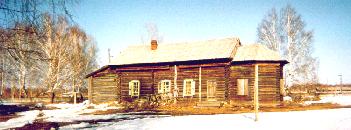
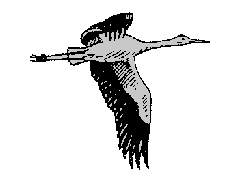 Forty Birds in Estonian Folk Belief. IV
Forty Birds in Estonian Folk Belief. IVEnn Ernits
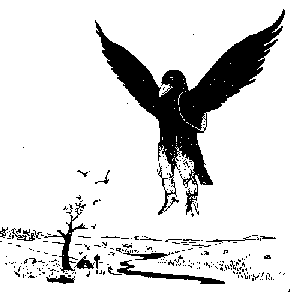
In the second part of the research is treated the most important event of the adult life of Meandash - getting married. Marriage between a man and an animal is based on totemistic conceptions. The stories of Meandash finding a wife and marrying her can be divided into two or three Subgenres. Of the first, the author knows only three versions, of the second twelve versions, but of the third - unless it is a forage or a combination of occasions - only one.
The first subgenre is characterized by marrying a wife from beyond the river of blood, the second by a threesome of suitors (a raven, a seal and a reindeer), and the third by the bride observing how the food is prepared, which is forbidden. In the first subgenre, the totemistic and shamanlike way of thought is reflected, in which a reindeer man marries a mortal. The river of blood is in the Lapp conceptions the border separating the human and the mythical reindeer world. It is a border between the world of life and death, companions and ancestors. This border can only be crossed by a shaman, who turns into an otter (compare "Kalevala" XVI: 369-372), or uses incantations to make the river dry. In the latter case he uses alder cambium which is analogous to blood. In these stories is represented the motif of a house built of reindeer bones (Compare "Kalevala«, XXI: 159-162). Thus the house of the mythical reindeer is the reindeer himself. Here is expressed the microcosm of the Lapps and the traditions connected with the skeleton. The threshold of the reindeer's house were neckbones. It seems that the semantics of the neck has not been awarded proper attention in the Finno-Ugric religion history. The purposes of telling stories of getting married were 1) passing on information about the ancestors of the tribe and 2) separating the moral from the immoral for didactic purposes.
Subgenres of the second kind express the way the reindeer people were imagined to be and to emphasize the benefits of originating from the reindeer rather than from the raven or the seal (distinctions are drawn between the own and the foreign). Everything connected with the house in the stories of this subgenre reflects the opposition pair culture - nature. Meandash is in the house as an anthropomorphic being, but in nature he acts as an animal. He enters the house through the backdoor that is usually used to bring in prey; but the reindeer of our story is at the same time the hunter and the prey as he is hunting those like him.
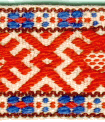 The possible meaning of the parallel words blue and red in runo
songs.
The possible meaning of the parallel words blue and red in runo
songs.What rises from there, blue from the swamp,/ blue from the swamp, red from the earth? The article deals with red and blue in runo songs.
The usage of color words in runo songs depends on: the possibilities of the existing language; the poetics of the runo song, the regional style, the world concept at the time of the runo song's creation.
The frequency of using color words depends on the song's plot (they are mostly connected with marring fantasies and puzzle songs) and inside that, on its turn, on the song type. Colors are connected with not a certain song but rather with historically developed stereotypical phrases. In a runo song they mark certain situations or phenomena. Blue and red in parallel verses hint to border situations in man's life (wedding, birth) or in nature (the border of night and day). The pair of colors has other meanings as well as it is statistically often found and semantically many-sided.
Of 772 songs, color names were mentioned in 175 and all in all 37 different color words were used. Of the contemporary Estonian well-known color names were used red, blue, gray, black, white, rarely were used green and yellow from the list were absent brown, pink, violet, orange. Runo songs were recorded in the 19th century. Black, white, red, blue became the basic color names already before the 17th century. Instead of yellow, golden is often used. Green as a basic color name has been known since the middle of the 17th century and is found in runo songs only occasionally. Brown - a loan word from the 18th century - is not at all found in runo songs. From this we can not actually conclude that the stereotypical runo song expressions connected with color words had been formed before the 17th century. For example we often meet in runo songs the word gray as a basic color name, but it became a basic color only in the 18th century. At the same time, the earlier basic color name bright (`haldjas') noting green, is absent in runo songs (it is used in the contemporary meaning that marks shining, glowing or the color of a limited group of notions - i.e. the greenness of trees). The glossary of runo songs was still developing in the 18th century. Earlier color names (white, black, red, blue) give ample stereotypical expressions, red-blue in different meanings and word pictures.
The main characteristic feature of the earlier layer of Estonian runo songs is alliteration (purjetan punasta merda `I am sailing the red sea') and parallelism (minu hella eidekene,/ siruta sinine lõnga,/ poeta punane lõnga,/ keera kullakarvaline,/ tõmba tütar taeva_aie `my dear old woman,/ stretch a blue thread,/ give a red thread,/ twist a golden-colored,/ pull your daughter up to the heavens').*1
Color words form alliterational word pairs, for example päev - punane (`day - red'); puu - punane (`tree - red') (päev läks puudele punane; /õun on/ päeva poolt punasikene; üks oli puu punane põõsas; Poolamaal puu punane,/ punasem on meie velle `the red day went to the trees; /the apple is/ red from the day's side; one tree was a red bush; in Poland trees are red,/ redder than our brothers'). These word pairs are different morphologically as well as semantically. From the point of view of the song's semantics, more important of the alliterating word pairs are those that belong together into one parallelism group and form general notions (characteristic of archaic thinking) through a certain given list. The blue-red is often accompanied by white or golden - a semantic mark of border. Separately the words do not have this meaning.
Runo songs' poetry has big regional differences. The parallelism of blue-red characterizes first of all the North-Estonian song area. The tradition there is more based on the earlier tradition and earlier stereotypical formulas are preserved. South-Estonian runo song is more characterized by improvisationality and thus the song formula is more changing.
Songs are based on nature and the material world. In a certain culture, the surrounding is interpreted by traditional expressions. For example, with the notion of border the blue-red-parallelism is used as these are visible-perceivable in the real world (i.e. sunset). It is characteristic of the runo song language to form general notions in the form of a concrete list. The important thing being that the singers of this land have worded their songs in that way already before us. Nature, religion, experience, form - all these determine the border in runo songs to be at the same time red and blue.
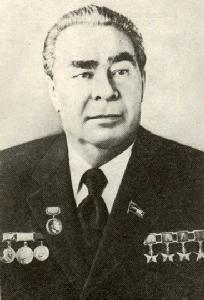
The collecting expedition of the Estonian Folklore Archive (participated by Anu Korb, Ell Vahtramäe, Aivar Jürgenson and the author) this time headed for the nearby villages of Tara city, Omsk oblast.
Villages situated near the Siberian taiga were founded in the end of the last century by emigrants. Of the original 11 villages near Tara, only four have survived. Due to their fairness, isolation and compactness, Jurjevka, Lilliküla and Estonka have maintained South-Estonian language. Currently, in Lilliküla are about 170, in Estonka 70 and Jurjevka about 25 inhabitants, the majority of them Estonian. The village of Mihhailovka, situated across the Irtõsh, was founded in 1906 and there are concentrated inhabitants from the surrounding Finnish, Estonian and Russian villages. Estonians are the minority in the village and the village language is mainly Russian.

Estonian villages are the centers of maintaining Estonian language and customs. Although they listen to Russian radio, watch Russian television programs, children of the village speak Estonian. People born in the 1950s and 60s living in the city with their children often have passive knowledge of the language, but their children speak only Russian.
The majority of village inhabitants are made up of Estonians about 70 years old. The small pension money is not enough to live on, so it is their own houshold that they live on. The youth has trouble finding work as in smaller villages work was previously found in collective farms and now there are none left. Comfort is often sought from alcohol. Even moral support from Estonia would be of help but it is the sad truth that because of material and authority trouble there has been little contact with Estonia. Thus they are genuinely glad of anybody coming from Estonia and according to their tradition, hospitality is limitless.